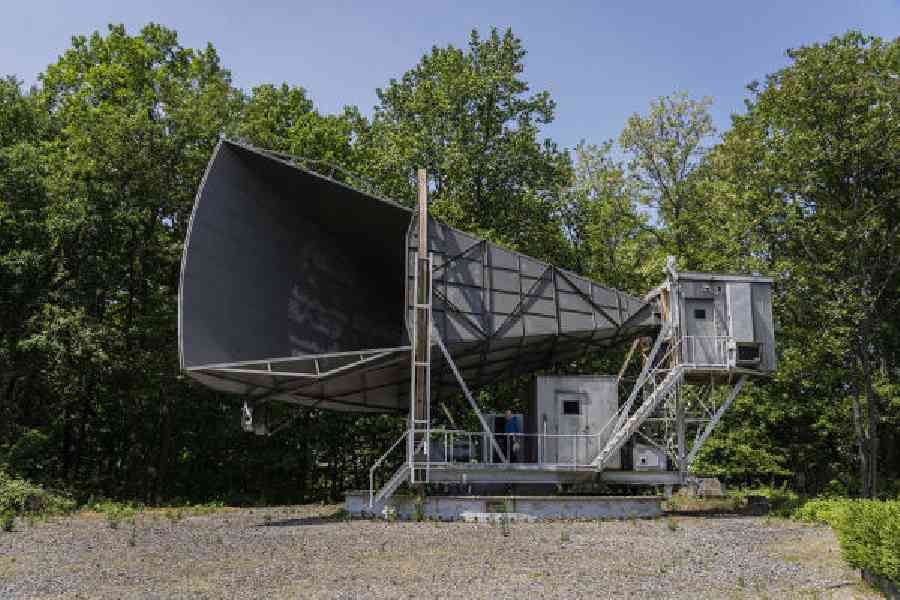On a field just below the summit of Crawford Hill, the highest point in Monmouth County, New Jersey, US, almost within sight of the skyscrapers of Manhattan, sits a cluster of shacks and sheds. Next to them is the Holmdel Horn Antenna, a radio telescope somewhat resembling the scoop of a giant steam shovel: an aluminium box 20 feet square at the mouth and tapering to an 8-inch opening, through which the radio waves are funnelled into the “cab”, a wooden hut on stilts.
What it once mined was the sky. While listening with the antenna in May 1964, two young radio astronomers, Arno Penzias and Robert Wilson, picked up an eerie and persistent hum from the heavens. They eventually learned, they had detected the beginnings of space and time. They were listening to the last sigh of the Big Bang, which birthed the universe 13.8 billion years ago and is detectable now only as a faint, omnipresent hiss of microwave radiation.
Up until then, scientists had debated whether the universe even had a beginning; maybe it was timeless. That query was now settled.
In 1978, Penzias and Wilson were awarded the Nobel Prize in physics for their
discovery, and in 1988, the antenna was designated a National Historic Landmark, a symbol of humankind’s ingenuity, curiosity and persistence, and of nature’s ability to surprise and humble us.
Wilson, now 87, lives in Holmdel and still has the keys to the telescope. When he offered an invitation to visit this spring, I jumped at the chance. The antenna was at the centre of a real estate dispute: The new owner of the site wanted to build a senior housing development there and possibly displace the antenna. The neighbours and various citizen groups were in an uproar. As a photographer and I made our way to Wilson’s house, we passed lawn sign after lawn sign: “Save Crawford Hill,” they said. “Save the Horn Antenna.”
The Holmdel Horn was built in 1959 by Bell Laboratories for an experiment called Project Echo. When the project was done, Bell turned the antenna over to two young astronomers: Penzias, who had left Nazi Germany before the Holocaust and earned a doctorate from Columbia, US, and Wilson, a radio whiz from Houston with a doctorate from the California Institute of Technology, US.
The beginning of time was the last thing on their minds; they wanted to measure the brightness of galaxies. To do so, Penzias and Wilson first had to calibrate the antenna by studying sources whose brightness or temperatures were known.
“On May 20, 1964, we got it all together,” Wilson said when I caught up to him in Holmdel. But, he recalled, there had been a troublesome surprise — a persistent hiss wherever they pointed the telescope.
The intrusive noise corresponded to a temperature of about 3.5 kelvin, barely yet clearly above the absolute zero that they had expected from empty space. It was present no matter in what direction they pointed the antenna. Try as they might, they could not get rid of the extra heat.
On the long list of potential wrongs were two pigeons that had roosted in the narrow end of the antenna and the “white dielectric material”, as Penzias called it, that they had left behind. “And they had decorated it the way they decorate various statues,” Wilson said.
The pigeons were sent away. “A couple of days later, they were right back,” Wilson said. A more permanent eviction was arranged. But even after cleaning the telescope, the buzz remained, eluding all explanation for nearly a year. “We were at wit’s end,” Wilson said.
A few miles away, Robert Dicke, a physicist at Princeton, US, and his students had begun looking into the conditions under which the universe could have begun. They concluded that any such Big Bang must have been hot enough to sustain thermonuclear reactions, at millions of degrees, in order to synthesise heavy elements from primordial hydrogen.
That energy should still be around, they realised. But as the universe expanded, the primaeval fireball would have cooled to a few kelvin above absolute zero — which, they calculated, would put the cosmic radiation in the microwave region of the electromagnetic spectrum.
Dicke assigned two graduate students — David Wilkinson, a gifted instrumentalist, and James Peebles, a theorist — to try to detect these microwaves. As the group was meeting to decide on a plan of action, the phone rang. It was Penzias. When Dicke hung up, he turned to his team. “Boys, we’ve just been scooped,” he said.
The two teams met and wrote a pair of papers, which were published back-to-back in the journal Physical Review Letters. The Bell Labs group described the radio noise, and the Princeton group proposed that it could be leftover heat from the Big Bang.
Wilson was in the middle of the fight to save the horn antenna. He has maintained cordial relations with Rakesh Antala, the new property owner, and credits him with allowing access to the antenna and protecting it.
“I’d like it to stay where it is,” he said, referring to the horn. “And I think the idea of making it into a park is a good one.” He noted that the antenna had suffered some vandalism, including broken windows. “So it needs some protection,” he said.
NYTNS










